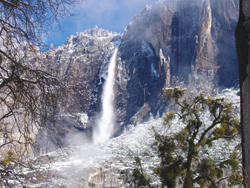Yosemite & Beyond: Tuolumne County Calls
Tuolumne County, California, 133 miles east of San Francisco, is best known for housing Yosemite National Park. Yet the county itself is chock-full of hidden treasures that would please any vacationer or environmentalist yearning for a deeper connection with the great outdoors.

Whether horseback riding into the pristine Stanislaus National Forest, hiking with members of the United States Forest Service (USFS), or discovering the glory that is Yosemite Valley, Tuolumne County’s environment has a life all its own. And its residents intend to keep it that way.
Home to picturesque waterfalls and one of the most photographed valleys in the country, Yosemite itself is still a park in progress. It continues to withstand the test of time, even with increased human interaction and natural occurrences. While the park was unprepared for the devastating flood of 1997, preventative measures are currently underway to anticipate Mother Nature. “Prescribed burns” occur in the park to simulate the 30-year natural cycle of fire that comes through the forest. These maintained fires rid the park of diseased trees and make room for younger foliage.
With enough outdoor activities to keep one busy for weeks, a visitor’s average stay in the park is only four hours. One tour guide advises visitors to literally “take a hike” and take in at least one aspect of Yosemite fully.
Projects are currently underway to make the park look more appealing to visitors, but not everyone is gung ho about the plans. The Lower Falls Restoration Project has converted one parking lot into a picnic area. Yet parking and transportation in the park, according to some observers, is a problem that has not been fully dealt with. Some locals offer tips to ease your way.
Go Early
Much of the congestion in the Valley floor is due to the removal of more than 6,000 developed parking spaces, leaving less than 1,500 slots available for visitors. “It seems to have made more of a problem by removing services before having a replacement system available,” says Denise Brooks, chief financial officer of Friends of Yosemite Park Association, which is dedicated to the preservation and enhancement of the park.
By visiting the Valley during off-peak hours (before 11 a.m. or after 2 p.m.) or during early spring or fall, visitors can help combat the traffic problem. Taking less crowded hikes through the north and south rim of the Valley also provides a better view and more rewarding hike, according to Brooks.
For decades, residents have done their part to preserve Tuolumne County’s natural beauty. “Check dams” were constructed deep in its forest during the 1950s as a way to regulate the flow of water. Made from natural elements such as twigs and branches, these manmade dams punctuate the unspoiled rivers and lakes one can view while horseback riding into the forests. Removing the dams might cause the bodies of water to dry up.
The United States Forest Service (USFS) has offered its support for the dams. Yet some local environmental groups want their forests “pristine, without any elements of human imprint” and see the dams as a violation.
“In Tuolumne, this environment is our life,” says Peggy Mosley, innkeeper at the Groveland Motel and supporter of the dams. “We want to protect it, not see it go away, and these dams are a way to do this.”
Many county residents balance their economic interests with environmental concerns. Mosley’s motel is introducing large, refillable dispensers in each of her rooms, eliminating the need for wasteful plastic bottles full of hygiene products. Groveland Motel’s rates start at $135.
Guests at the charming Friends of Yosemite Lodge in Groveland can savor organic food, enjoy the picturesque grounds and organic gardens, and breathe easy because of the fragrance-free cleaning products. Guests must become members of Friends of Yosemite Park ($10), and the themed rooms (John Muir, Ansel Adams) start at $159 per night, double occupancy.
During a guided hike with members of USFS, the officers” dedication becomes clear. “If a fire gets past 20 acres, you take it personally,” says Pamela Lane, a member of prevention and detection lookout for the USFS. Climbing the ladder to her lookout station, Lane is always in awe of the beauty that surrounds her. “One of the best things about my job is the fact that people know someone is watching over them,” she says.
“We’ve got a real gift here,” adds Eric Ferrel, recreation technician for the USFS. “As long as we take care of it, it will take care of us.”
Contacts

